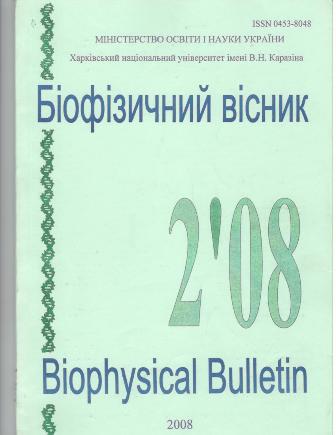Optical properties and structure of jc-1 j-aggregates in solutions
Abstract
Using the stationary optical spectroscopy the optical properties of J-aggregates of cyanine dye JC-1 have been investigated. The model of the J-aggregates structure has been proposed. It has been supposed that at high dye concentration the dye dimers are the main building unit of the J-aggregates linear chains. It has been shown the absorption and luminescence spectra of the dimers. Such model of JC-1 J-aggregates structure is proposed for the first time
Downloads
References
2. Kobayashi T. (Ed.) J-Aggregates. Singapore: World Scientific Publishing. – 1996. – 230 p.
3. Шапиро Б.И. Молекулярные ансамбли полиметиновых красителей // Успехи химии. – 2006. – Т.
75, № 5. – С. 484–510.
4. Smiley S.T., Reers M., Mottola-Hartshorn C. et al. Intracellular heterogeneity in mitochondrial membrane
potentials revealed by a J-aggregate-forming lipophilic cation JC-l // Proc. Natl. Acad. Sci. USA. – 1991.
– Vol. 88. – P. 3671–3675.
5. Salvioli S., Ardizzoni A., Franceschi C., Cossarizza A. JC-1, but not DiOC6(3) or rhodamine 123, is a
reliable fluorescent probe to assess ΔΨ changes in intact cells: implications for studies on mitochondrial
functionality during apoptosis // FEBS Letters. – 1997. – Vol. 411. – P. 77–82.
6. Wang M., Silva G.L., Armitage B.A. DNA-Templated Formation of a Helical Cyanine Dye J-Aggregate //
J. Am. Chem. Soc. – 2000. – Vol. 122. – P. 9977–9986.
7. Jones R.M., Lu L., Helgeson R. et al. Building highly sensitive dye assemblies for biosensing from
molecular building blocks // Proc. Natl. Acad. Sci. USA. – 2001. – Vol. 98, № 26. – P. 14769–14772.
8. Legrand O., Perrot J.-Y., Simonin G. et al. JC-1: a very sensitive fluorescent probe to test Pgp activity in
adult acute myeloid leukemia // Blood. – 2001. – Vol. 97, № 2. – 502–508.
9. Van B1erkom J., Davis P., Mathwig V., Alexander S. Domains of high-polarized and low-polarized
mitochondria may occur in mouse and human oocytes and early embryos // Human Repr. – 2002. – Vol.
l7, № 1. – P. 393–406.
10. Guralchuk G.Ya., Sorokin A.V., Katrunov I.K. et al. Specificity of cyanine dye L-21 aggregation in
solutions with nucleic acids // J. Fluorescence. – 2007. – Vol. 17, № 4. – P. 370–376.
11. Гуральчук Г.Я., Гринёв Р.С., Катрунов И.К. и др. Применение агрегатов цианиновых красителей
для детекции нуклеиновых кислот // Биофиз. вестн. ХНУ. – 2007. – Т. 18, № 1. – С. 102–107.
12. Birkan B., Gü1len D., Özçelik S. Controlled Formation of the Two-Dimensional TTBC J-Aggregates in
an Aqueous Solution // J. Phys. Chem. B. – 2006. – Vol. 110. – P. 10805–10813.
13. Давыдов А.С. Теория молекулярных экситонов. Москва: Наука. – 1968. – 296 с.
14. Guralchuk G.Ya., Katrunov I.K., Grynyov R.S. et al. Anomalous Surfactant-Induced Enhancement of
Luminescence Quantum Yield of Cyanine Dye J-Aggregates // J. Phys. Chem. C. – 2008. – Vol.112, №
38. – P. 14762-14768.
Authors who publish with this journal agree to the following terms:
- Authors retain copyright and grant the journal right of first publication with the work simultaneously licensed under a Creative Commons Attribution License that allows others to share the work with an acknowledgement of the work's authorship and initial publication in this journal.
- Authors are able to enter into separate, additional contractual arrangements for the non-exclusive distribution of the journal's published version of the work (e.g., post it to an institutional repository or publish it in a book), with an acknowledgement of its initial publication in this journal.
- Authors are permitted and encouraged to post their work online (e.g., in institutional repositories or on their website) prior to and during the submission process, as it can lead to productive exchanges, as well as earlier and greater citation of published work (See The Effect of Open Access).





